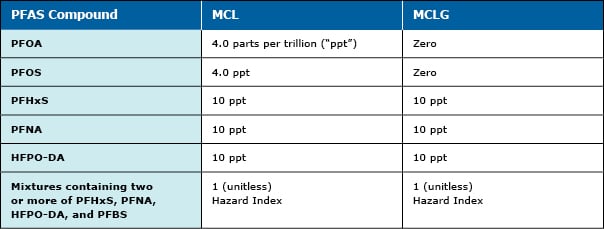
EPA Issues the First-Ever National Drinking Water Standard for PFAS
The EPA has announced the first-ever national drinking water standard for certain PFAS substances as well as a $1 billion investment to address PFAS in drinking water.
On April 10, 2024, the U.S. Environmental Protection Agency ("EPA") announced its highly anticipated final National Drinking Water Regulation ("NPDWR") for six per-and polyfluoroalkyl substances ("PFAS"), which establishes legally enforceable Maximum Contaminant Levels ("MCLs") and health-based, non-enforceable, Maximum Contaminant Level Goals ("MCLGs") for each PFAS.
Under the final rule, the MCLs and MCLGs are as follows:

As a result, U.S. public water systems are required to complete initial monitoring for these substances by 2027 (as well as ongoing compliance monitoring) and provide the public with information on the levels of these PFAS substances in public drinking water beginning in 2027. In addition, public water systems are required to implement solutions that reduce these PFAS substances in their drinking water by 2029 if monitoring shows that the drinking water levels exceed the MCLs. Starting in 2029, public water systems that exceed these MCLs will be found to be in violation of the NPDWR and required to undertake remedial action as well as notify the public of the violation.
EPA also announced nearly $1 billion in newly available funding through the Bipartisan Infrastructure Law, with the aim of helping states and territories to implement PFAS testing and treatment at public water systems as well as to help owners of private wells address PFAS contamination.
EPA's final rule is significant in that it reflects the Biden Administration's "PFAS Strategic Road Map" and its emphasis on enacting regulations to curb alleged exposure to PFAS substances. However, public water systems will likely need to implement one or more available (or new) technologies to reliably detect (and meet) PFAS at the levels set by EPA. We expect the final rule to be subject to legal challenges, which could result in a stay of the rule while such actions are resolved.








